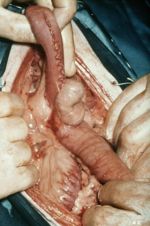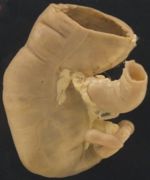Caecum - Anatomy & Physiology
Jump to navigation
Jump to search
Introduction
The caecum is a blind ending diverticulum of the large intestine and it exists at the junction of the ileum and the ascending colon. It's size and physiological importance vary between species. It is a site of microbial fermentation, absorption and transportation.
Structure
- It communicates with the ileum via the ileal orifice and with the colon via the caecocolic orifice.
- It consists of a base, body and apex, the apex being the blind-ending portion.
- It is attached to the ileum by a fold of peritoneum called the ileocaecal fold.
Function
Microbial Fermentation
- The contribution of this is species dependant. The products of fermentation are VFAs.
Absorption
- VFAs that are produced are absorbed here.
Transportation
- Segmental contractions facilitate absorption and microbial actitivity.
- Every 3-5 minutes, segmentation is replaced by mass movements. This is similar to peristalsis, but large portions of the caecum contract simultaneously to move chyme into the colon.
Histology
Species Differences
Canine
- On the right side of the abdomen.
- Unique because it has no direct connection to the ileum.
- Short and held in a spiral shape against the ileum by the ileocaecal fold.
- Little microbial fermentation takes place.
Ruminant
- On the right side of the abdomen in the supraomental recess
- The apex points caudally.
- Relatively small and featureless: there are no taenia or haustra.
- Some microbial fermentation takes place.
Equine
- A significant amount of fermentation takes place.
Porcine
- On the left side of the abdomen, with the apex pointing caudoventrally.
- Cylindrical in shape.
- Three taenia are present
- The ventral taenia provides the attachment for the ileocaecal fold.
- The lateral and medial taenia are free.
Test yourself with the Caecum flashcards
Links
- Pathology of the Small and Large Intestines
- Peyer's Patches
- Pot 48 The Small and Large intestine of the Ruminant
- Pot 52 Lateral view of the Abdomen of a young Ruminant
- Lateral View of the Equine Abdomen
- Left Sided topography of the Equine abdomen
- Right sided topography of the Equine Abdomen
- Pot 357 The Feline Abdomen
- Small and Large intestine of the Sheep
- The Porcine Abdomen

